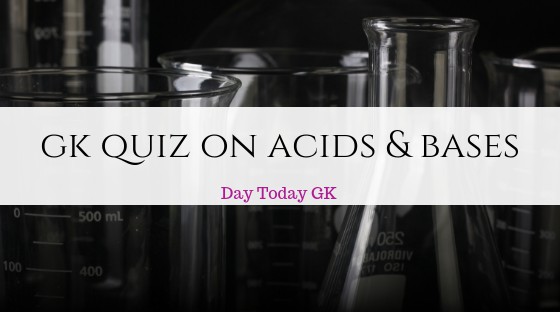GK Quiz on Acids and Bases
GK Quiz on Acids and Bases | Acids and Bases are very important for our life. In lower classes, we studied a lot about these. In our day today life, the usage of Acids and Bases has become very common.
Practice our GK Quiz on Acids and Bases and check out how well you remember what you studied in Chemistry during school days.

GK Quiz on Acids and Bases
GK Quiz on Acids and Bases
1. Which of the following about Acids are TRUE?
a) Acids pH have level below 7 on a Zero to Fourteen scale
b) Acids have a sour taste
c) Acids can carry an electric current
d) All the above
2. Which Acid is beneficial for those who have kidney stones?
a) Malic Acid
b) Oxalic Acid
c) Citric Acid
d) Lactic Acid
3. Which Acid is also known as Apple Acid?
a) Ascorbic Acid
b) Lactic Acid
c) Malic Acid
d) Tartaric Acid
4. Which Acid is also known as Vitamin C?
a) Ascorbic Acid
b) Lactic Acid
c) Citric Acid
d) Tartaric Acid
5. Which Acid has the smallest molecules of all the alpha-hydroxy acids?
a) Glycolic Acid
b) Tartaric Acid
c) Oxalic Acid
d) Sulphuric Acid
6. Which acid is derived from dairy products?
a) Madelic Acid
b) Malic Acid
c) Lactic Acid
d) Hydrochloric Acid
7. Name the Acid that is usually derived from bitter almond?
a) Sulphuric Acid
b) Mandelic Acid
c) Perchloric Acid
d) Hydroiodic Acid
8. Which acid is used for making explosives?
a) Hydrochloric Acid
b) Sulphuric Acid
c) Nitric Acid
d) Hydrobromic acid
9. Which acid has the Nickname ‘King of Chemicals’?
a) Hydrochloric Acid
b) Nitric Acid
c) Bromic Acid
d) Sulphuric Acid
10. Which acid is predominant in soft drinks?
a) Perchloric Acid
b) Phosphoric Acid
c) Lactic Acid
d) Sulfonic Acid
11. Haloacetic acids are chemical compounds that contain chlorine and _________.
a) Iodine
b) Bromine
c) Melanine
d) Acetylene
12. Name the Scientist who is known for being the first person to synthesize, ingest, and learn of the psychedelic effects of lysergic acid diethylamide (LSD)?
a) Alfred Hannan
b) John Robert
c) Varys Grey
d) Albert Hofmann
13. Baking soda is the common name of ______________.
a) Calcium Carbonate
b) Calcium Bicarbonate
c) Sodium Carbonate
d) Sodium Bicarbonate
14. Which of the following is also referred as Saltpetre?
a) Potassium Nitrate
b) Calcium Carbonate
c) Sodium Chloride
d) Zinc Sulphate
15. An antacid is a substance which neutralizes stomach acidity and is used to relieve heartburn, indigestion or an upset stomach. Which of the following is the common component of Antacids?
a) Magnesium hydroxide
b) Sodium hydroxide
c) Magnesium sulphate
d) Sodium bicarbonate
















